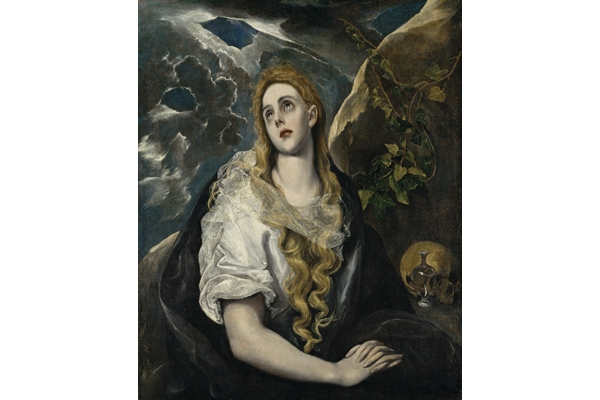In 1895 the Spanish art collector John Charles Robinson donated a picture to the National Gallery. ‘On the whole I think it is very much above the average of this most eccentric master’s work,’ he phrased his offer less than enticingly. ‘At the same time you know the man was mad as a hatter and his work must be taken with “all faults” of which there are plenty.’
The man was Domenikos Theotokopoulos, aka El Greco, and the picture was ‘Christ Driving the Traders from the Temple’. To an English late 19th-century audience weaned on Murillo this ‘most eccentric master’ — a Cretan-born Byzantine icon painter turned Venetian colourist turned Spanish Mannerist — looked dangerously outré. But to a new wave of artists in continental Europe the master’s faults had started to look like virtues. In France, Cézanne paid him the compliment of updating his ‘Lady in a Fur Wrap’ as a ‘Femme au Boa’, and Picasso enlisted the nudes in his ‘Vision of Saint John’ as models for ‘Les Demoiselles d’Avignon’.
But it was in Germany that El Greco attracted the most passionate following among the ragtag band of outlaws known as Expressionists, after ten of his paintings appeared in a touring exhibition from the collection of the Hungarian Marczell von Nemes. In Munich in 1911 their appearance overlapped with the inaugural show of Der Blaue Reiter; in Düsseldorf in 1912 it coincided with a Sonderbund exhibition in nearby Cologne, which included two El Grecos alongside works by Cézanne and Picasso. The painter of prophets was hailed as a prophet of modernism — Grecomania had struck.
A century on, its impact is assessed in El Greco and Modernism, an exhibition at Düsseldorf’s Museum Kunstpalast juxtaposing 40 works by El Greco with 60 by assorted German and Austrian Expressionists — plus a representative sample of paintings by Cézanne and Picasso in the role of forerunners who prepared the way for the master, creating the modernist prism through which he would be seen. These include Picasso’s ‘Woman Resting on her Elbow’ (1909) — a Cubist take on the ‘Lady in a Fur Wrap’ — and some fine Cézannes from out-of-the-way collections, including the late ‘Three Skulls on a Patterned Carpet’ (Kunstmuseum Solothurn), which sit comfortably alongside four El Greco paintings of St Francis meditating on death.
If Cézanne was visionary in a rationalist way that satisfied the French analytical mind, El Greco was visionary in a mystical way that satisfied the German soul. German Expressionism sprang from a desire not to apprehend appearances more clearly but to see beyond them to what Max Beckmann called ‘the idea which hides itself behind so-called reality’. In El Greco’s late visual language, with its elongations and distortions, circling compositions and vertical perspectives, eerie lighting and flickering broken colour, a restless generation on the brink of war found the enlightened disregard for reality that the times called for. Brooding in his Berlin attic, the young Ludwig Meidner was inspired to give Grecoesque expression to ‘my oppressive feelings on love, Last Judgments, the destruction of the world, etc., for in those days the toothy grin of the world storm already cast its frightening shadow over my plaintive brush’.
Grecomania reopened the door to religious themes which, when the world storm broke, acquired heightened significance. Invalided out of the army with a nervous breakdown, Beckmann painted his etiolated ‘Descent from the Cross’ (1917), bathed in a sallow light that grotesquely caricatures El Greco’s palette. Christ’s body is so absurdly elongated that the crucifix’s crossbar reaches his waist, and his fluttering hands with their long tapering fingers are an obvious extension of El Greco’s.
Fluttering hands are the mark of the Greco disciple. We see them in Oskar Kokoschka’s contemporary ‘Annunciation’ (1911), with its pregnant fräulein and naked angel posing like El Greco’s ‘Penitent Magdalene’; in Heinrich Nauen’s ‘Christ on the Mount of Olives’ (1921) and in Max Oppenheimer’s secular martyr, ‘The Bleeding Man’ (1911). The theme of martyrdom resonated with young artists returning from the war: the exhibition parades a small detachment of Saint Sebastians by Albert Weisgerber, Hermann Stenner and Egon Wilden. But it was El Greco’s cataclysmic skies that inspired the prophetic Meidner, whose ‘Apocalyptic Landscape’ of 1912 already appears to be under heavy bombardment.
For the uninitiated, the show provides a crash course in German Expressionism. It introduced me to the arresting sculptures of Wilhelm Lehmbruck, whose bronze ‘Ascending Youth’ of 1913 anticipates Giacometti by four decades, and the whimsical paintings of Albert Bloch — the token American in Der Blaue Reiter — who adapted El Greco’s visionary perspective to the unlikely subject of a ‘Prize Fight’ (1912–13). But it would be worth visiting for the El Grecos alone, which include late masterpieces such as ‘The Vision of Saint John’ and ‘Laocoon’ alongside sumptuous early works like the portrait of ‘Charles de Guise, Cardinal of Lorraine’ competing for sartorial dominance with a macaw.
Düsseldorf is making up for a lost opportunity: a hundred years ago the city was offered the Nemes collection and turned it down. The El Grecos were auctioned off in Paris in 1913, but not before the time-travelling Greek had left his eccentric imprint on modern German art.





Comments